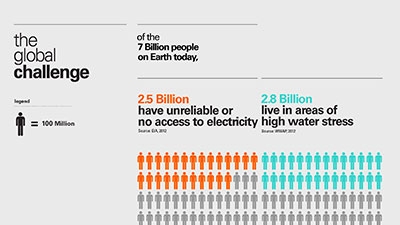Energy and water security are crucial to human and economic development. The two resources are now more interconnected than ever -- significant amounts of water are needed in almost all energy generation processes, from generating hydropower, to cooling and other purposes in thermal power plants, to extracting and processing fuels. Conversely, the water sector needs energy – mainly in the form of electricity – to extract, treat and transport water. Both energy and water are used in the production of crops, including those used to generate energy through biofuels.
But energy and water resources are under unprecedented pressure, and there is growing competition for their use from people, industries, ecosystems, and growing economies. As the world’s population reaches 9 billion, demand will require a 50 percent increase in agricultural production and a 15 percent increase in already-strained water withdrawals. By 2035, the world’s energy consumption will increase by 35 percent, which in turn will increase water use by 15 percent and consumption by 85 percent, according to the International Energy Agency.
Climate change will add more uncertainty through increased water variability and more frequent and severe floods and droughts. Energy systems are becoming ever more vulnerable to the impacts of climate change. As temperatures get warmer, so do the rivers and lakes that power plants draw their cooling water from - which makes it harder to generate electricity in the coming decades.
“We cannot meet our global energy goals of extending access to the poor, increasing efficiency and expanding renewables without water. The water energy interrelationship is critical to build resilient as well as efficient, clean energy systems. The time to act is now,” said Rachel Kyte, World Bank Group Vice President and Special Envoy for Climate Change.
Risks to the energy sector
Water scarcity is already threatening the long-term viability of energy projects worldwide. Last year alone, water shortages shut down thermal power plants in India, decreased energy production in power plants in the United States and threatened hydropower capacity in many countries, including Sri Lanka, China and Brazil.
Nearly 93 percent of the Middle East’s onshore oil reserves are exposed to medium to extremely high overall water quantity risks. Developing countries are the most vulnerable, as they often lack capacity to meet the rapidly growing need.
Despite these concerns, current energy planning and production is often made without taking into account existing and future water constraints nor risks of extreme events. As Executive Director of the IEA, Maria van der Hoeven, explains, “Planners and decision-makers in both sectors often remain ill-informed about the drivers of these challenges, how to address them, and the merits of different technical, political, management, and governance options. The absence of integrated planning is unsustainable.”

